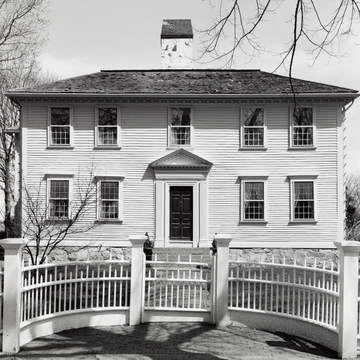Wickford's grandest eighteenth-century house was built by the grandson of the town's founder. It typifies the American translation into wood of the blocky five-bay house of England's middle class. When its elaborate detail is compared to the plainness of Old St. Paul's, one can see what great strides classicism had taken on this side of the Atlantic during the intervening forty years. In the 1920s the house was moved back on its site and remodeled by Norman Isham for Alonzo T. Cross, the inventor of the Cross pen and a prominent Rhode Island industrialist. The effect of the paired trees and the tall turned fence with a central bow framing the elegant pedimented entrance clearly represent the romantic viewpoint of Isham's colonial revivalism. So does the trellising toward the front of the side elevation, meant perhaps for a frame of vines. The door surround has a copybook precision and elegance that suggest Isham's hand. He is definitely responsible for the ell and the sunroom/porch to the rear overlooking the harbor. Farther along, number 95, a simpler variant of the Updike House, contains a door with much the same qualities as that of its neighbor, together with a scale and sophistication against the straightforward builder's elevation that again points to Isham. And there is more of Isham's fencing.
You are here
John Updike House
If SAH Archipedia has been useful to you, please consider supporting it.
SAH Archipedia tells the story of the United States through its buildings, landscapes, and cities. This freely available resource empowers the public with authoritative knowledge that deepens their understanding and appreciation of the built environment. But the Society of Architectural Historians, which created SAH Archipedia with University of Virginia Press, needs your support to maintain the high-caliber research, writing, photography, cartography, editing, design, and programming that make SAH Archipedia a trusted online resource available to all who value the history of place, heritage tourism, and learning.

